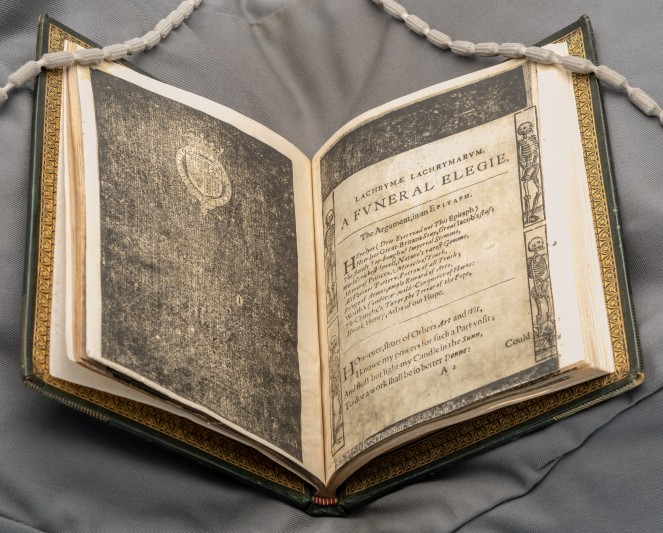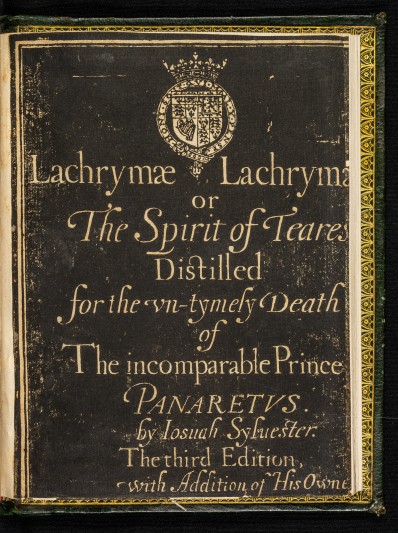Elizabeth Henderson, Rare Books Librarian, writes: In 2020 the University of St Andrews was able, through the generosity of the Friends of the National Libraries, to purchase a rare and fascinating volume containing two editions of Josuah [Joshua] Sylvester’s mourning poetry for Prince Henry. The volume contains the bookplate of the bibliophile Sir Thomas Brooke (1830-1908) of Armitage Bridge House, near Huddersfield. The privately printed catalogue of his library from 1891 suggests that the editions were not bound together at that point, and that the cataloguer was unaware that ‘Sundry Funeral Elegies’ was the second part of the third edition of Lachrymae Lachrymarum, as it is described as ‘apparently forming part of a larger work’.
Sylvester (1562/63–1618) was a poet and translator who sought patronage from James VI & I and his eldest son Prince Henry. Prince Henry became his main patron, granting him an annual pension. In Lachrimae Lachrimarum Sylvester joined the public mourning and literary outpouring of grief that followed Henry’s sudden death in November 1612. The 1613 edition also includes verses by poets such as Hugh Holland, Henry Cornwallis, Sir Edward Herbert, Sir Henry Goodyear, Sir William Sidney, and contains the first printing of ‘Look to me, Faith; and look to my Faith, God’, by John Donne. This is one of only seven poems which Donne allowed to be printed in his lifetime, as he preferred to circulate his verse among a restricted audience in manuscript.
James VI & I and Prince Henry have a particular connection to the Library at the University of St Andrews, through their gifts of books. Henry’s gift is dated 4 August 1612 (just months before his death) and by the time his books had arrived and were listed he is referred to as ‘of sacred memory’. An early library inventory in the muniments collection here thus captures a very particular historical moment and links to the shock felt across the country at Henry’s death.
Many of the books published in response to Henry’s death used visual metaphors to enhance their expression of grief, for example by printing a ‘field of tears’ on the title page. The extremely unusual printing technique of white-line woodcuts, with white outlines or lettering on an otherwise black page, epitomised mourning. Sylvester’s work is a particularly ambitious example of this, with each verso printed entirely in black apart from the Prince’s coat of arms, coronet and garter, while on the rectos woodcut borders of skeletons and cadavers enclose the text.
As Sarah Werner has pointed out, the Early English Books Online digitised images (from a microfilm) for the third edition shows the title page with conventional black lines on white – that is, the image has been wrongly ‘corrected’, and now misrepresents the original white lines on a black title page. Acquiring a physical copy of this book allows our students to encounter the design accurately, but it will also be a powerful teaching tool to discuss the authenticity of digital images of rare and early printed books – a subject which has newly been introduced to the Material Bibliography curriculum, but which is of increasing importance for researchers in any aspect of the history of the book.
There are already plans to incorporate this exciting purchase into a variety of modules at both undergraduate and postgraduate level. There is research interest from academics working on Prince Henry and the Stuarts, notions of imperial monarchy under James VI and I, printing history and the use of woodcuts in English books, and the poetry of John Donne. The bibliographical complexity of the editions was singled out as a particular attraction by our early modern specialists. Close study of the volume since it arrived has thrown up intriguing possibilities for further research into the different states of the printing, with evidence that the arrangement of the woodcut borders is not identical on every page of different copies of what are identified as the same state.

